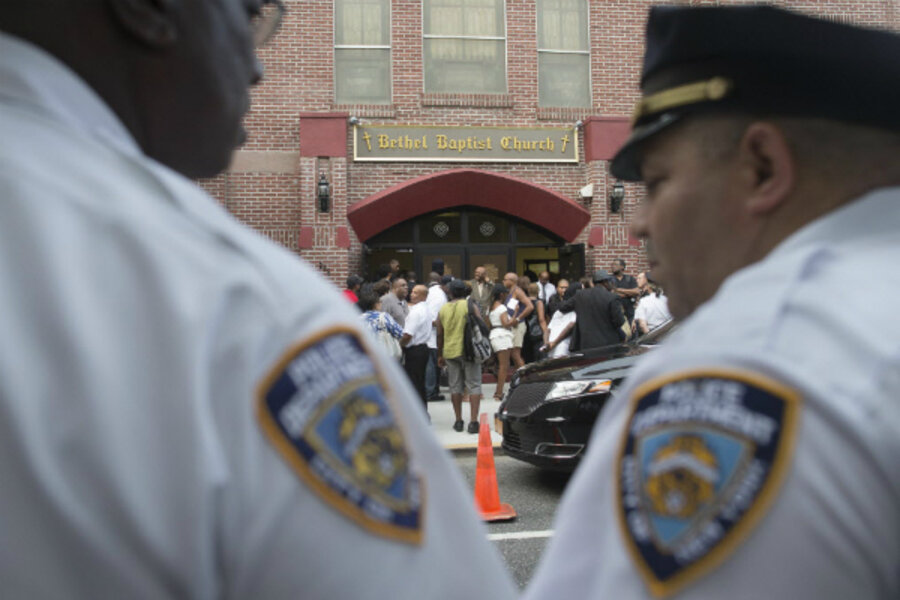NYC Mayor Bill de Blasio walks thin blue line in chokehold aftermath
| ATLANTA
The homicide death of Staten Island’s Eric Garner by police chokehold on July 17 has given New York Mayor Bill de Blasio his first major crisis: how to appease angry residents without alienating the nation’s largest police force?
The death of Mr. Garner has put the liberal Democrat’s chief campaign promises – to lower crime and improve relations between cops and poorer residents – into uncomfortable focus, forcing Mr. de Blasio to confront institutional tactics and problems even as cops and residents continue to seethe over what happened.
"This has to be a turning point moment," de Blasio said on Friday. "We can't let any moment that leaves us so sad and pained be an end point. It has to be an opening of a door to something better."
Amateur video showed how several police officers surrounded Garner as he complained about getting hassled. At one point, an officer forces Garner to the ground with a chokehold. “I can’t breathe,” Garner said before passing out, and dying. A medical examiner called it homicide by chokehold, noting that Garner’s health issues also contributed to his death.
Garner resisted arrest after being suspected of selling untaxed cigarettes on the street. He had a long history of arrests for minor street crimes, including marijuana possession. He left behind a wife, children, and grandchildren. His death has mobilized civil rights activists, who plan a major protest later this month that could close down some of the city’s already congested streets.
The city medical examiner ruled it a homicide. No charges have yet been filed in the case, though six people – two NYPD officers and four emergency management technicians – have been administratively disciplined for their handling of the case. According to the video, the EMTs declined to try to revive the dying man.
The video was dramatic enough, showcasing a callous attitude toward the people the city is supposed to serve. It’s also raised new questions about the city’s decades-old “broken windows” policing concept where police officers make arrests for penny-ante crimes in order to discourage more serious criminality.
Police Commissioner William Bratton said on Friday that he wanted to counter "some of the misimpressions and some of the momentum that's been gained by self-serving interests" since Garner's videotaped death last month.
"Are there more minorities impacted by enforcement? Yes. I'm not denying that," he said in an interview with The Associated Press. "But it's not an intentional focus on minorities. It's a focus on behavior."
"We are not a racist organization – not at all," he added.
Patrick Lynch, head of the influential Patrolmen’s Benevolent Association, and other police officials have reacted angrily to the appearance of de Blasio and Mr. Bratton next to the Rev. Al Sharpton, the head of the National Action Network, cable TV host, and long-time NYPD critic.
At one forum, Mr. Sharpton, seated next to the mayor, suggested that de Blasio’s own mixed-race son would be a “candidate for a chokehold” by the NYPD. The practice has officially been banned since 1993, but hundreds of chokehold complaints have been made in recent years.
Mr. Lynch said it’s “outrageously insulting” to suggest that NYPD goes out “to choke all people of color." According to the AP, other union officials have hinted that New Yorkers can expect work slowdowns by cops over the controversy.
De Blasio has tried to avert the debate becoming about personalities rather than policy. “I don't think it's about any individual personality or the rhetoric of any one leader,” he said last week. “It is about a series of substantive changes already underway and that are about to deepen a lot more. I think a lot of people are ready to make this change.”
Whether that change means de Blasio is rethinking his wholesale support for so-called “broken windows” policing is still unclear. Even though serious crime has dropped dramatically in the city, some experts say that the theory may have run its course, particularly because of backlash from the black community and, as became evident in the Garner death, that it may put nonviolent residents in danger. Over 80 percent of those given low-level court summonses are black and Hispanic.
"Serious crime has decreased dramatically in New York City in the two decades that broken windows policing has been in force, yet the causal connection between that drop and huge numbers of arrests for minor transgressions is unproven to this day," Steve Zeidman, a City University of New York law professor, wrote recently.
If NYPD ranks are upset at de Blasio for appearing to side with Sharpton’s fiery rhetoric, de Blasio’s supporters now are also questioning whether his support for Bratton, the long time police commissioner, and the broken windows concept – which includes the controversial “stop-and-frisk” tactic – is anathema to repairing trust between cops and residents in tougher parts of town.
“De Blasio’s commitment to undoing stop and frisk helped to solidify his support among black and brown voters – many felt he offered hope of a paradigm shift in the way the city’s poorer communities would be policed,” writes Trymaine Lee, for MSNBC.com. “But in light of Garner’s death – which began with the paltry offense of selling 50-cent cigarettes on a city street – and all of the controversy kicked up around it, questions have arisen as to how this administration’s policing of communities of color will differ from those that came before it.”






